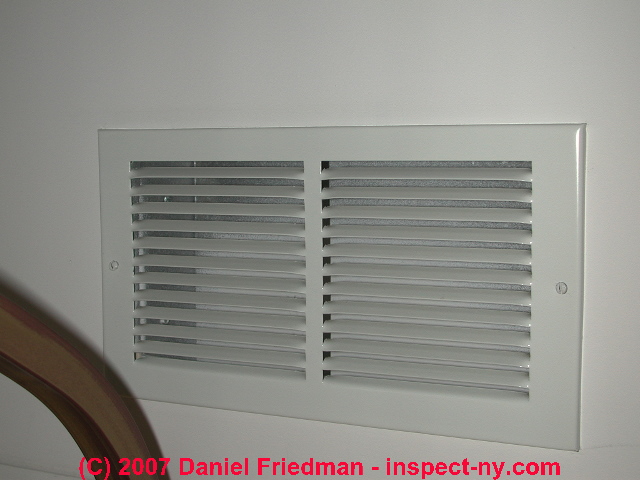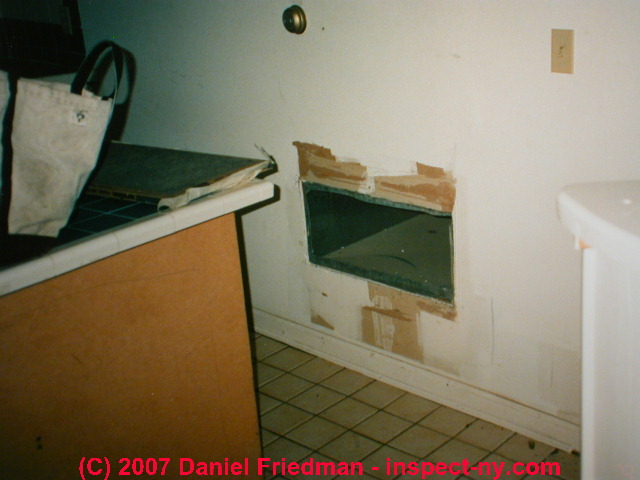 Under-sized Heating or Cooling Return Air Ducts
Under-sized Heating or Cooling Return Air Ducts
- POST a QUESTION or COMMENT about too-small or blocked or undersized air conditioning, heating, and heat pump ductwork return air registers and duct connections
Undersized return air duct problem diagnosis & cure: this HVAC ductwork article describes the problem undersized return air openings - a problem that can be observed during inspection of the defects in return air ducts for heating or cooling systems (HVAC).
We also discuss duct troubles such as such as missing air conditioning cool air supply or return air registers, undersized air conditioning duct openings, improper cooling duct routing, cooling (or heating) air duct corrosion, leaky air duct connections, defective heating or cooling ductwork materials.
The photograph above shows a small HVAC return air duct located on an interior building wall. Whether or not this return air duct is adequate depends on how many such returns were installed in the building and whether or not the return air capacity is balanced with the air handler and air supply ducting.
InspectAPedia tolerates no conflicts of interest. We have no relationship with advertisers, products, or services discussed at this website.
- Daniel Friedman, Publisher/Editor/Author - See WHO ARE WE?
UNDERSIZED OPENINGS - Under-sized Return Air Openings/Ducts

AIR CONDITIONING & HEAT PUMP SYSTEMS, of which this is a chapter, describes the inspection of residential air conditioning systems (A/C systems) to inform home buyers, owners, and home inspectors of common cooling system defects. Asbestos in or on HVAC ducts is a possible hazard for which we provide links to a separate document - see "Asbestos HVAC Ducts" at below left.
Under-sized single central air return:
when we see a comparatively small single air return in a building, such as a 12X18" grille in a ceiling or wall, we suspect that insufficient return air ducts are present. This concern is elaborated next.
The photograph shows an under-sized single air return for a duct system serving an entire two story home. We increased the size of the return duct to match the air handler and observed a doubling of the air flow in the system from this single improvement!
Central return air openings are very likely to be undersized when we see that the opening measurements are much smaller than the opening for air provided right at the blower fan.
At another example installation, the blower fan or return air plenum opening at the furnace was 20"x18" while the return air opening at the door to the utility room was 13"x13" (reduced further in effective size by a louvered screen).
When we see amateur attempts to add supply or return air to a system, such as observation of unanticipated openings in building walls, rough-sawn door undercuts, additional openings cut in the return duct or plenum near the air handler, we suspect system design problems. It is possible that previous occupants have found that the warm air supply was not adequate.
Should you confirm problems with inadequate heat delivery in some areas you'll want to consult with an HVAC engineer to make accurate measurements.
Door undercuts, central cool air return:
If room doors are shut and not under-cut to permit air flow out of the room, the system's ability to cool the room may be reduced, sometimes significantly.
Try running the cooling system for 10 minutes with all room doors shut. Then open a room door slightly and see what happens!
When a building uses a central return air grille and doors are not undercut heating some rooms may be difficult - system cannot push cold air from the cooled or heated room back to the furnace.
While modest amounts of new duct work (to take return air from the living area) are usually not costly, extensive re-ducting of air flow may involve significant expense
...
...
Continue reading at AIR FLOW IMPROVEMENT, HVAC - topic home, or select a topic from the closely-related articles below, or see the complete ARTICLE INDEX.
Or see these RETURN AIR INCREASE FAQs questions and answers about how to improve the return air supply to the air handler in your building.
Or see these
Recommended Articles
Suggested citation for this web page
UNDERSIZED RETURN DUCTS at InspectApedia.com - online encyclopedia of building & environmental inspection, testing, diagnosis, repair, & problem prevention advice.
Or see this
INDEX to RELATED ARTICLES: ARTICLE INDEX to HVAC DUCT SYSTEMS
Or use the SEARCH BOX found below to Ask a Question or Search InspectApedia
Ask a Question or Search InspectApedia
Try the search box just below, or if you prefer, post a question or comment in the Comments box below and we will respond promptly.
Search the InspectApedia website
Note: appearance of your Comment below may be delayed: if your comment contains an image, photograph, web link, or text that looks to the software as if it might be a web link, your posting will appear after it has been approved by a moderator. Apologies for the delay.
Only one image can be added per comment but you can post as many comments, and therefore images, as you like.
You will not receive a notification when a response to your question has been posted.
Please bookmark this page to make it easy for you to check back for our response.
IF above you see "Comment Form is loading comments..." then COMMENT BOX - countable.ca / bawkbox.com IS NOT WORKING.
In any case you are welcome to send an email directly to us at InspectApedia.com at editor@inspectApedia.com
We'll reply to you directly. Please help us help you by noting, in your email, the URL of the InspectApedia page where you wanted to comment.
Citations & References
In addition to any citations in the article above, a full list is available on request.
- Thanks to Mark Cramer, Tampa Florida, for assistance in technical review of the "Critical Defects" section and for the photograph of the deteriorating gray Owens Corning flex duct in a hot attic. Mr. Cramer is a Florida home inspector and home inspection educator.
- Thanks to Jon Bolton, an ASHI, FABI, and otherwise certified Florida home inspector who provided photos of failing Goodman gray flex duct in a hot attic.
- Owens Corning Duct Solutions - www.owenscorning.com/ductsolutions/ - provides current HVAC ductwork and duct insulating product descriptions and a dealer locator. Owens Corning Insulating Systems, LLC, One Owens Corning Parkway, Toledo, OH 43659 1-800-GET-PINK™
- "Flexible Duct Media Fiberglas™ Insulation, Product Data Sheet", Owens Corning - see owenscorning.com/quietzone/pdfs/QZFlexible_DataSheet.pdf
"Owens Corning Flexible Duct Media Insulation is a lightweight, flexible, resilient thermal and acoustical insulation made of inorganic glass fibers bonded with a thermosetting resin." - Our recommended books about building & mechanical systems design, inspection, problem diagnosis, and repair, and about indoor environment and IAQ testing, diagnosis, and cleanup are at the InspectAPedia Bookstore. Also see our Book Reviews - InspectAPedia.
- Complete List of Air Conditioning & Heat Pump Design, Inspection, Repair Books at the InspectAPedia Bookstore.
- Modern Refrigeration and Air Conditioning, A. D. Althouse, C.H. Turnquist, A. Bracciano, Goodheart-Willcox Co., 1982
- Principles of Refrigeration, R. Warren Marsh, C. Thomas Olivo, Delmar Publishers, 1979
- Refrigeration and Air Conditioning Technology, 5th Ed., William C. Whitman, William M. Johnson, John Tomczyk, Cengage Learning, 2005, ISBN 1401837654, 9781401837655 1324 pages
- In addition to citations & references found in this article, see the research citations given at the end of the related articles found at our suggested
CONTINUE READING or RECOMMENDED ARTICLES.
- Carson, Dunlop & Associates Ltd., 120 Carlton Street Suite 407, Toronto ON M5A 4K2. Tel: (416) 964-9415 1-800-268-7070 Email: info@carsondunlop.com. Alan Carson is a past president of ASHI, the American Society of Home Inspectors.
Thanks to Alan Carson and Bob Dunlop, for permission for InspectAPedia to use text excerpts from The HOME REFERENCE BOOK - the Encyclopedia of Homes and to use illustrations from The ILLUSTRATED HOME .
Carson Dunlop Associates provides extensive home inspection education and report writing material. In gratitude we provide links to tsome Carson Dunlop Associates products and services.

